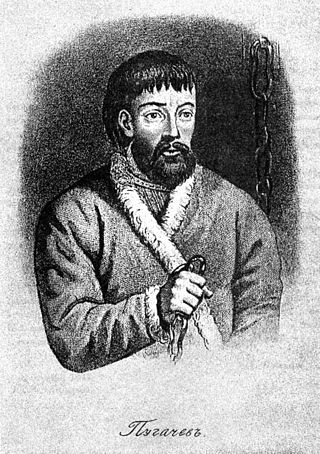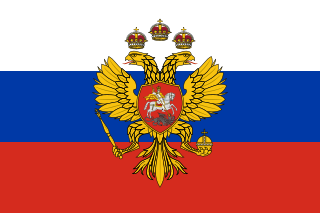Related Research Articles

A peasant is a pre-industrial agricultural laborer or a farmer with limited land-ownership, especially one living in the Middle Ages under feudalism and paying rent, tax, fees, or services to a landlord. In Europe, three classes of peasants existed: non-free slaves, semi-free serfs, and free tenants. Peasants might hold title to land outright, or by any of several forms of land tenure, among them socage, quit-rent, leasehold, and copyhold.

Serfdom was the status of many peasants under feudalism, specifically relating to manorialism, and similar systems. It was a condition of debt bondage and indentured servitude with similarities to and differences from slavery, which developed during the Late Antiquity and Early Middle Ages in Europe and lasted in some countries until the mid-19th century.

Yemelyan Ivanovich Pugachev was an ataman of the Yaik Cossacks and the leader of the Pugachev's Rebellion, a major popular uprising in the Russian Empire during the reign of Catherine the Great.

The emancipation reform of 1861 in Russia, also known as the Edict of Emancipation of Russia, was the first and most important of the liberal reforms enacted during the reign (1855–1881) of Emperor Alexander II of Russia. The reform effectively abolished serfdom throughout the Russian Empire.

The term serf, in the sense of an unfree peasant of tsarist Russia, is the usual English-language translation of krepostnoy krest'yanin which meant an unfree person who, unlike a slave, historically could be sold only together with the land to which they were "attached". However, this stopped being a requirement by the 19th century, and serfs were practically indistinguishable from slaves. Contemporary legal documents, such as Russkaya Pravda, distinguished several degrees of feudal dependency of peasants. While another form of slavery in Russia, kholopstvo, was ended by Peter I in 1723, the serfdom was abolished only by Alexander II's emancipation reform of 1861.

Nikolay Alexeyevich Milyutin was a Russian statesman remembered as the chief architect of the great liberal reforms undertaken during Alexander II's reign, including the emancipation of the serfs and the establishment of zemstvo.

The Tsardom of Russia or the Russian Tsardom and Tsardom of Rus', also known as the Tsardom of Muscovy, was the centralized Russian state from the assumption of the title of tsar by Ivan IV in 1547 until the foundation of the Russian Empire by Peter the Great in 1721.

The country of Georgia became part of the Russian Empire in the 19th century. Throughout the early modern period, the Muslim Ottoman and Persian empires had fought over various fragmented Georgian kingdoms and principalities; by the 18th century, Russia emerged as the new imperial power in the region. Since Russia was an Orthodox Christian state like Georgia, the Georgians increasingly sought Russian help. In 1783, Heraclius II of the eastern Georgian kingdom of Kartli-Kakheti forged an alliance with the Russian Empire, whereby the kingdom became a Russian protectorate and abjured any dependence on its suzerain Persia. The Russo-Georgian alliance, however, backfired as Russia was unwilling to fulfill the terms of the treaty, proceeding to annex the troubled kingdom in 1801, and reducing it to the status of a Russian region. In 1810, the western Georgian kingdom of Imereti was annexed as well. Russian rule over Georgia was eventually acknowledged in various peace treaties with Persia and the Ottomans, and the remaining Georgian territories were absorbed by the Russian Empire in a piecemeal fashion in the course of the 19th century.

The Russian Empire, also known as Imperial Russia, was the final period of the Russian monarchy from its proclamation in November 1721, until its dissolution in late 1917. It consisted of most of northern Eurasia. The Empire succeeded the Tsardom of Russia following the Treaty of Nystad. The rise of the Russian Empire coincided with the decline of neighbouring rival powers: the Swedish Empire, the Polish–Lithuanian Commonwealth, Qajar Iran, the Ottoman Empire, and Qing China. It also held colonies in Russian America between 1799 and 1867. Covering an area of approximately 22,800,000 square kilometres (8,800,000 sq mi), it remains the third-largest empire in history, surpassed only by the British Empire and the Mongol Empire; it ruled over a population of 125.6 million people per the 1897 Russian census, the only census carried out during the entire imperial period. Owing to its geographic extent across Europe, Asia, and North America at its peak, it featured great ethnic, linguistic, religious, and economic diversity.

The Galician Peasant Uprising of 1846, also known as the Galician Rabacja, Galician Slaughter, or the Szela uprising, was a two-month uprising of impoverished Austrian Galician peasants that led to the suppression of the szlachta uprising and the massacre of szlachta in Galicia, in the Austrian Partition zone, in early 1846. The uprising, which lasted from February to March, primarily affected the lands around the town of Tarnów.
Abolition of serfdom in Poland occurred over a period of time. At the end of 18th century a reform movement in Poland resulted in the Constitution of May 3, 1791 which took the peasantry under protection of state. Full abolishment of serfdom was enacted by the Proclamation of Połaniec on 7 May 1794, but it was also short-lived as Poland got partitioned by her neighbours in 1795, beginning first 12 years of Polish inexistence as an independent state (1795-1807) and later another 103 years (1815-1918). In the 19th century various reforms on Polish territories were taking place. Namely in all three of the Austrian partition, Prussian partition and the Russian partition. Serfdom was abolished in Prussia in 1807, in Austria in 1848, in Russia in 1861. Despite these facts 7 May 1794 remains the date serfdom was abolished in Poland.

Serfdom in Poland became the dominant form of relationship between peasants and nobility in the 17th century, and was a major feature of the economy of the Polish–Lithuanian Commonwealth, although its origins can be traced back to the 12th century.

Like slavery, serfdom has a long history that dates to ancient times.
State serfs or state peasants were a special social estate (class) of peasantry in 18th–19th century Russia, the number of which in some periods reached half of the agricultural population. In contrast to private serfs, state serfs were considered personally free, although attached to the land. They were liberated in 1866.

Slavery in Lithuania existed as serfdom or baudžiava which is, in turn, derived from Lithuanian bausmė (punishment) on the territory of Grand Duchy of Lithuania, continued to exist throughout Rzeczpospolita period and later under the rule of Russian empire until Emancipation reform of 1861.
David Moon is anniversary professor in history at the University of York. He is a specialist in the rural life of the Russian Empire from the seventeenth to the twentieth centuries. Moon also has an interest in environmental history and has received an International Network Grant for £123,000 from the Leverhulme Trust for research in that area.
The Government reforms imposed by Tsar Alexander II of Russia, often called the Great Reforms by historians, were a series of major social, political, legal and governmental reforms in the Russian Empire carried out in the 1860s.
In the second half of the nineteenth century, it became clear that the preservation of the power and political influence of the Russian Empire is impossible without reform and transformation of the entire political system. Among the economic prerequisites, it should be noted the crisis of the landlord economy, the poverty of the peasants, the low purchasing power of the population, from which the underdevelopment of the domestic market ensued. Serfdom held back the development of the wage labor market and created a shortage of labor for industry. Therefore, the reign of Alexander II became a period of fundamental transformations of Russian society.
Livonian Peasants' Laws were laws introduced in the 19th century for Governorate of Livonia of the Russian Empire. About the same time similar laws has been enacted in all Baltic governorates and Duchy of Courland and Semigallia. These laws changed and clarified peasants rights and obligations, who ethnically were mainly Estonians and Latvians. This development culminated in Peasant Community Code of 1866 which codified peasants self-governance.
Anarchism in Latvia emerged from the Latvian National Awakening and saw its apex during the 1905 Russian Revolution. Eventually the Latvian anarchist movement was suppressed by a series of authoritarian regimes in the country.
References
- ↑ Pennington, Donald (2015). Europe in the Seventeenth Century. Routledge. p. 98. ISBN 978-1317870982.
- 1 2 3 Colburn, Forrest D. (2016). Everyday Forms of Peasant Resistance. Routledge. p. 52. ISBN 978-1315491448.
- 1 2 3 4 Kahan, Arcadius (1989). Russian Economic History: The Nineteenth Century . University of Chicago Press. pp. 161–162. ISBN 978-0226422435.
- 1 2 3 4 5 Colburn, Forrest D. (2016). Everyday Forms of Peasant Resistance. Routledge. p. 52. ISBN 978-1315491448.
- 1 2 Stanziani, Alessandro (2014). After Oriental Despotism: Eurasian Growth in a Global Perspective. A&C Black. p. 55. ISBN 978-1472522658.
- 1 2 Jezierski, Andrzej (2003). Historia gospodarcza Polski (in Polish). Key Text Wydawnictwo. p. 43. ISBN 978-8387251710.
- ↑ Moon, David (1992). Russian Peasants and Tsarist Legislation on the Eve of Reform: Interaction between Peasants and Officialdom, 1825–1855. Springer. p. 26. ISBN 978-1349118335.
- ↑ Moon, David (1992). Russian Peasants and Tsarist Legislation on the Eve of Reform: Interaction between Peasants and Officialdom, 1825–1855. Springer. p. 25. ISBN 978-1349118335.
- ↑ Wenzer, Kenneth (2003). Land As an Economic Factor and Its Biblical Origins. iUniverse. p. 222. ISBN 978-0595299812.
- ↑ Sluglett, Peter (2011). The Urban Social History of the Middle East, 1750–1950. Syracuse University Press. pp. 127–128. ISBN 978-0815650638.
- ↑ Pennington, Donald (2015). Europe in the Seventeenth Century. Routledge. p. 101. ISBN 978-1317870982.
- ↑ Pihlajamäki, Heikki (2017). Conquest and the Law in Swedish Livonia (c. 1630–1710): A Case of Legal Pluralism in Early Modern Europe. Brill. p. 163. ISBN 978-9004331532.
- ↑ Czajewski, Jerzy (October 2004). "Zbiegostwo ludności Rosji w granice Rzeczypospolitej" [Russian population exodus into the Rzeczpospolita]. Promemoria (6/15). ISSN 1509-9091. Archived from the original on 3 January 2005.
- ↑ Kimla, Piotr (2011). "Przywary niewolników pańszczyźnianych w XVIII-wiecznej Rzeczypospolitej w relacji Huberta Vautrina". Annales Universitatis Mariae Curie-Skłodowska. Sectio G. Ius (in Polish). 58 (1): 87–97. ISSN 0458-4317.
- ↑ Wagner, W.J. (1992). "May 3, 1791, and the Polish constitutional tradition". The Polish Review. 36 (4): 383–395. JSTOR 25778591.
- ↑ Moon, David (1992). Russian Peasants and Tsarist Legislation on the Eve of Reform: Interaction between Peasants and Officialdom, 1825–1855. Springer. p. 24. ISBN 978-1349118335.